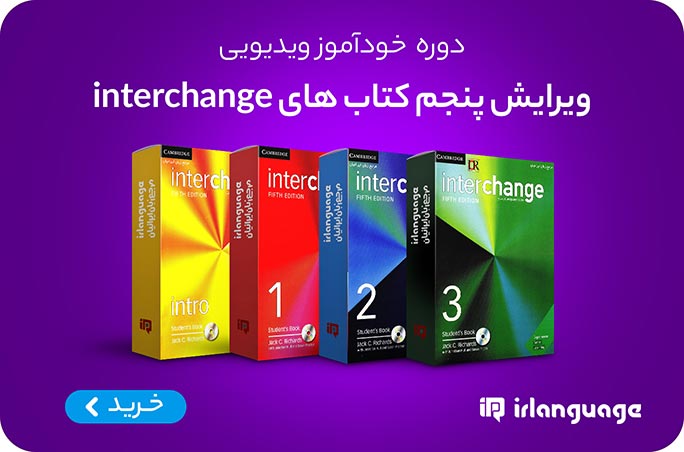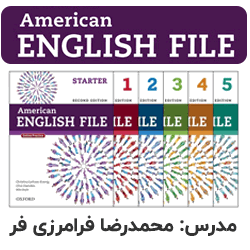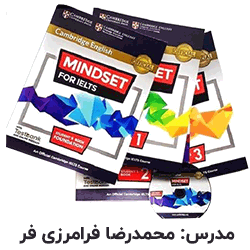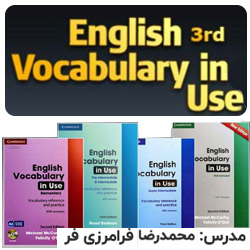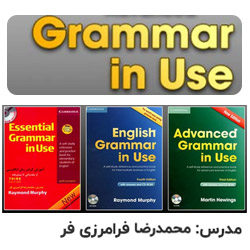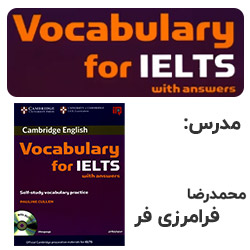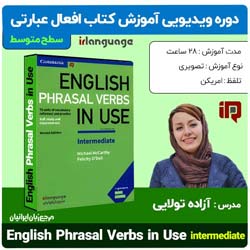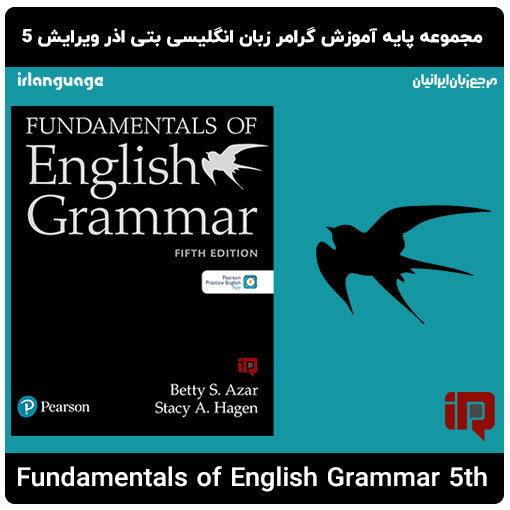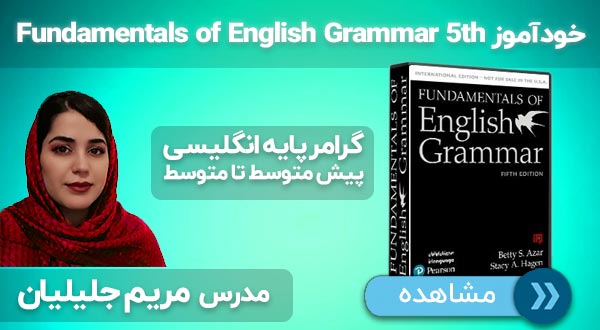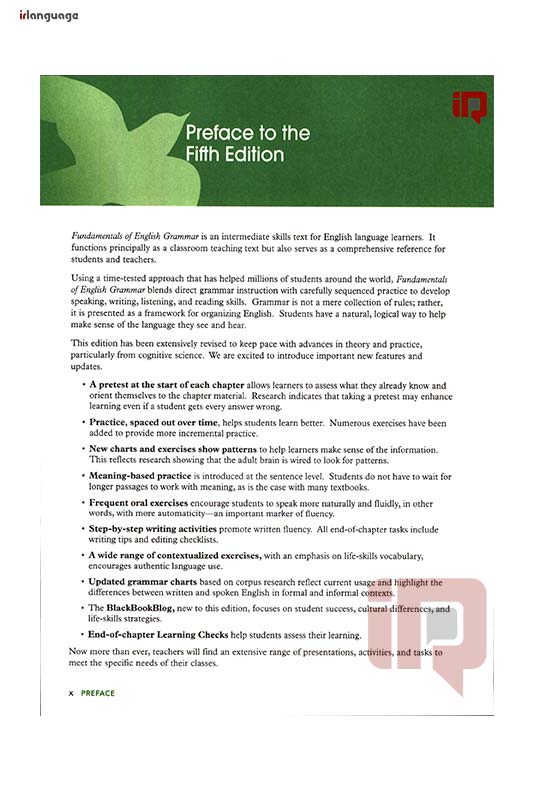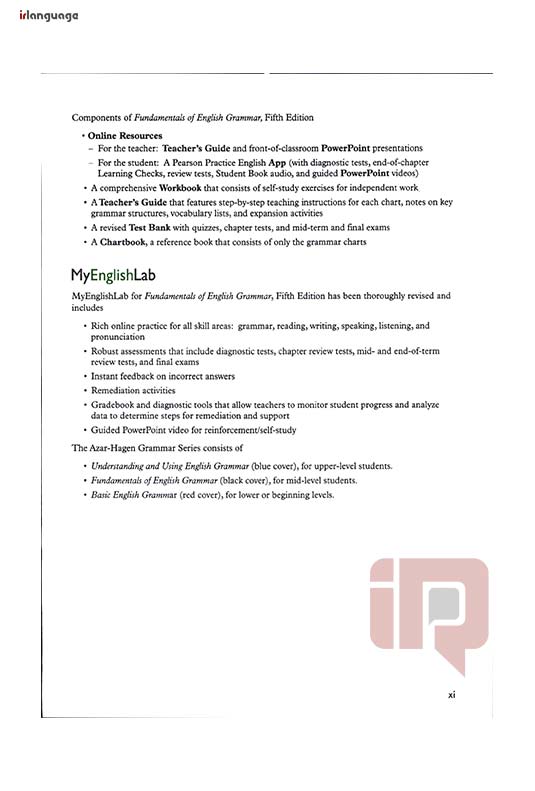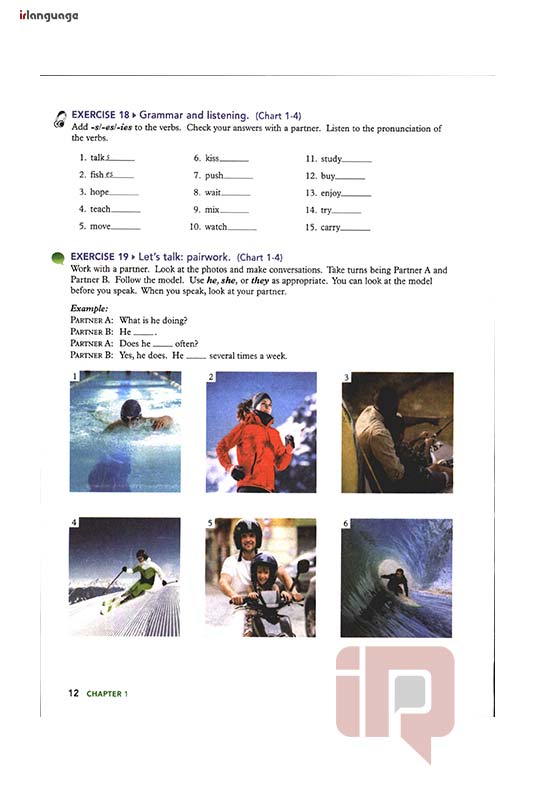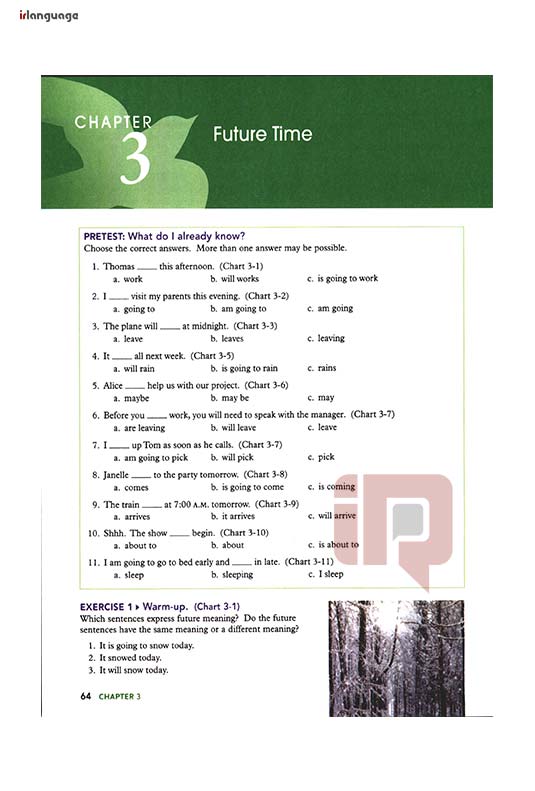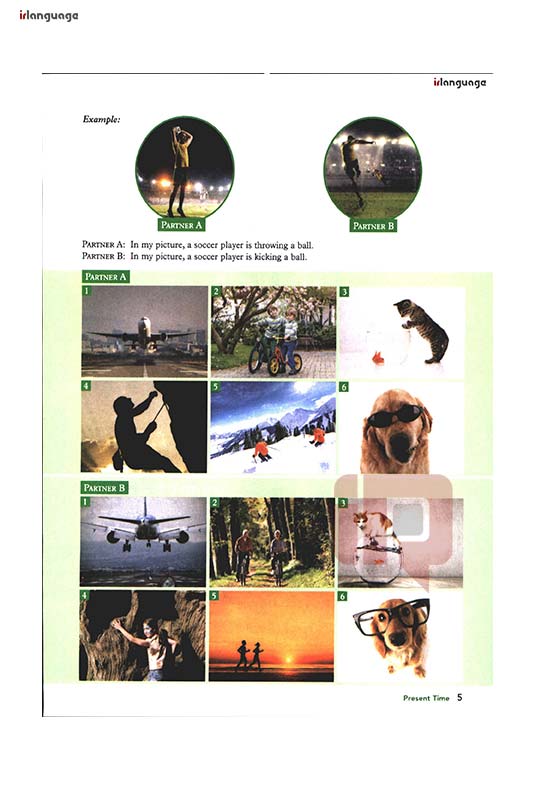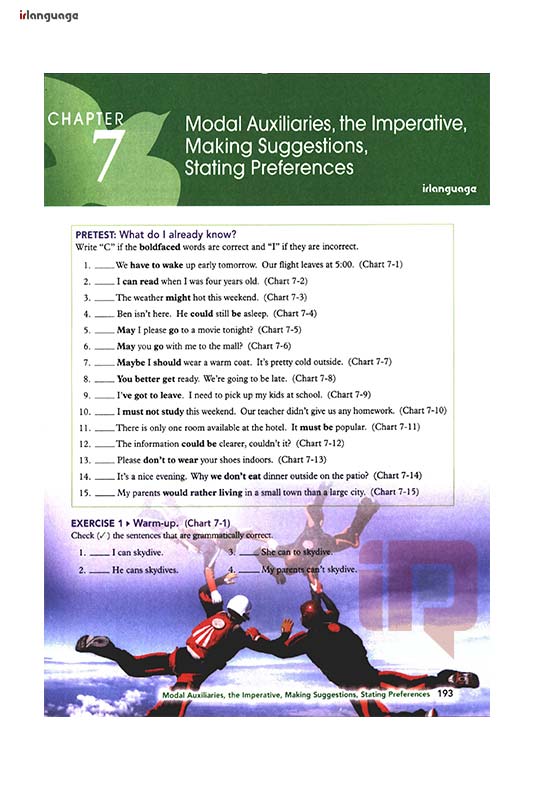|
کتاب Fundamentals of English Grammar 5th یکی از مهمترین رفرنس های موسسات آموزشی، موسسات علمی و آکادمیک و همچنین دانشگاه هاست. این کتاب که توسط نویسنده معروف Betty Azar از انتشارات پیرسون به چاپ رسیده است، اولین سری از این مجموعه است که به ارائه مباحث مهم و ضروری گرامر زبان انگلیسی پرداخته است. کتاب شامل یک فایل PDF، به همراه فایل های صوتی و ویدیویی است که در اختیار زبان آموزان قرار گرفته است. مهمترین فصول آموزشی این کتاب را می توانید در ادامه مطلب مشاهده نمایید. برای دانلود این مجموعه، مشاهده توضیحات بیشتر و موارد دیگر به ادامه مطلب مراجعه نمایید ...
برای دانلود این کتاب نیاز به خرید لینک دانلود دارید.
مهمترین مباحث و سرفصل های کتاب: Chapter 01 - PRESENT TIME 1-1 Simple Present and Present Progressive 1-2 Forms of the Simple Present and the Present Progressive 1-3 Singular/Plural 1-4 Spelling of Simple Present Verbs: Final -s/-es 1-5 Frequency Adverbs 1-6 Verbs Not Usually Used in the Progressive 1-7 Present Verbs: Short Answers to Yes/No Questions
Chapter 02 - PAST TIME 2-1 The Simple Past: Regular Verbs 2-2 Expressing Past Time: The Simple Past, Irregular Verbs 2-3 Common Irregular Verbs: A Reference List 2-4 Recognizing Verb Endings and Questions with Did 2-5 Spelling of -ing and -ed Forms 2-6 The Past Progressive 2-7 Simple Past vs. Past Progressive 2-8 Expressing Past Time: Using Time Clauses 2-9 Expressing Past Habit: Used To
Chapter 03 - FUTURE TIME 3-1 Expressing Future Time: Be Going To and Will 3-2 Forms with Be Going To 3-3 Forms with Will 3-4 Be Going To and Will in Spoken English 3-5 Be Going To vs. Will 3-6 Certainty About the Future 3-7 Expressing the Future in Time Clauses and If-Clauses 3-8 Using the Present Progressive to Express Future Time 3-9 Using the Simple Present to Express Future Time 3-10 Immediate Future: Using Be About To 3-11 Parallel Verbs
Chapter 04 - PRESENT PERFECT AND PAST PERFECT 4-1 Past Participle 4-2 Introduction to the Present Perfect: Unspecified Time with Ever and Never 4-3 The Present Perfect with Unspecified Time: Already, Yet, Just, Recently 4-4 Present Perfect with Since and For 4-5 Simple Past vs. Present Perfect 4-6 Present Perfect Progressive 4-7 Present Perfect Progressive vs. Present Perfect 4-8 Past Perfect
Chapter 05 - ASKING QUESTIONS 5-1 Yes/No Questions and Short Answers 5-2 Where, Why, When, What Time, How Come, What ... For 5-3 Questions With Who, Whom, and What 5-4 Using What + a Form of Do 5-5 Which vs. What and What Kind Of 5-6 Using How 5-7 Using How Often I How Many Times 5-8 Talking About Distance 5-9 Length ofTime: It+ Take and How Long; How Many 5-10 Spoken and Wrinen Contractions with Question Words 5-11 More Questions with How 5-12 Using How About and WhatAbout 5-13 Tag Questions
Chapter 06 - NOUNS AND PRONOUNS 6-1 Plural Forms of Nouns 6-2 Pronunciation of Final -s/-es 6-3 Subjects, Verbs, and Objects 6-4 Objects of Prepositions 6-5 Prepositions ofTime 6-6 Word Order: Place and Time 6-7 Subject-Verb Agreement 6-8 Using Adjectives to Describe Nouns 6-9 Using Nouns as Adjectives 6-10 Personal Pronouns: Subjects and Objects 6-11 Possessive Nouns 6-12 Using Whose 6-13 Possessive Pronouns and Adjectives 6-14 Reflexive Pronouns 6-15 Singular Forms of Other: Another vs. The Other 6-16 Plural Forms of Other: Other(s) vs. The Other(s) 6-17 Summary: Forms of Other
Chapter 07 - MODAL AUXILIARIES, THE IMPERATIVE, MAKING SUGGESTIONS, STATING PREFERENCES 7-1 Introduction to Modal Auxiliaries 7-2 Expressing Ability: Can, Could, Be Able To 7-3 Expressing Possibility: May, Might, and Maybe; Expressing Permission: May and Can 7-4 Using Could to Express Possibility 7-5 Polite Requests with /: May, Could, Can 7-6 Polite Requests with You: Would, Could, Will, Can 7-7 Expressing Advice: Should and Ought To 7-8 Expressing Advice: Had Bet ter 7-9 Expressing Necessity: Have To, Have Got To, Must 7-10 Expressing Lack of Necessity: Do Not Have To; Expressing Prohibition: Must Not 7-11 Making Logical Conclusions: Must 7-12 Tag Questions with Modal Auxiliaries 7-13 Imperative Sentences: Giving Instructions 7-14 Making Suggestions: Let's and Why Don't 7-15 Stating Preferences: Prefer, Like ... Better, Would Rather 7-16 Summary: Modal Auxiliaries Taught in Chapter 7
Chapter 08 - CONNECTING IDEAS: PUNCTUATION AND MEANING 8-1 Connecting Ideas with And 8-2 Connecting Ideas with But and Or 8-3 Connecting Ideas with So 8-4 Using Auxiliary Verbs After But 8-5 Using And + Too, So, Either, Neither 8-6 Connecting Ideas with Because 8-7 Connecting Ideas with Even Though/Although
Chapter 09 - COMPARISONS 9-1 Introduction to Comparative Forms of Adjectives 9-2 Introduction to Superlative Forms of Adjectives 9-3 Completing Comparatives and Superlatives 9-4 Making Comparisons with Adverbs 9-5 Repeating a Comparative; Using Double Comparatives 9-6 Modifying Comparatives with Adjectives and Adverbs 9-7 Negative Comparisons 9-8 Using As ... As to Make Comparisons 9-9 Using Less ... Than and Not As ... As 9-10 Using More with Nouns 9-11 Using The Same, Similar, Different, Like,Alike
Chapter 10 - THE PASSIVE 10-1 Active and Passive Sentences 10-2 Forming the Passive 10-3 Progressive Forms of the Passive 10-4 Transitive and Intransitive Verbs 10-5 Using the by-Phrase 10-6 Passive Modal Auxiliaries 10-7 Past Participles as Adjectives (Stative or Non-Progressive Passive) 10-8 Participial Adjectives: -ed vs. -ing 10-9 Get + Adjective; Get + Past Participle 10-10 Using Be Used/Accustomed To and Get Used/Accustomed To 10-11 Used To vs. Be Used To 10-12 Using Be Supposed To
Chapter 11 - COUNT/NONCOUNT NOUNS AND ARTICLES 11-1 A vs. An 11-2 Count and Noncount Nouns 11-3 Noncount Nouns 11-4 More Noncount Nouns 11-5 Using A Lot Of, Some, Several, Many/Much, and A Few/A Little 11-6 Nouns That Can Be Count or Noncount 11-7 Using Units of Measure with Noncount Nouns 11-8 Articles with Count and Noncount Nouns: A/An, The 11-9 More About Articles 11-10 Using The or 0 with People and Places 11-11 Capitalization
Chapter 12 - ADJECTIVE CLAUSES 12-1 Adjective Clauses: Introduction 12-2 Using Who and That in Adjective Clauses to Describe People 12-3 Using Object Pronouns in Adjective Clauses to Describe People 12-4 Using Pronouns in Adjective Clauses to Describe Things 12-5 Singular and Plural Verbs in Adjective Clauses 12-6 Using Prepositions in Adjective Clauses 12-7 Using Whose in Adjective Clauses
Chapter 13 - GERUNDS AND INFINITIVES 13-1 Verb+ Gerund 13-2 Go+ -ing 13-3 Verb + Infinitive 13-4 Verb + Gerund or Infinitive 13-5 Preposition + Gerund 13-6 Using By and With to Express How Something Is Done 13-7 Using Gerunds as Subjects; Using It + Infinitive 13-8 It + Infinitive: Using For (Someone) 13-9 Expressing Purpose with In Order To and For 13-10 Using Infinitives with Too and Enough
Chapter 14 - NOUN CLAUSES 14-1 Noun Clauses: Introduction 14-2 Noun Clauses That Begin with a Question Word 14-3 Noun Clauses That Begin with If or Whether 14-4 Noun Clauses That Begin with That 14-5 Other Uses of That-Clauses 14-6 Substituting So for a That-Clause in Conversational Responses 14-7 Quoted Speech 14-8 Quoted Speech vs. Reported Speech 14-9 Verb Forms in Reported Speech 14-10 Common Reporting Verbs: Tell, Ask, Answer/Reply
31 ارديبهشت 1400 |
بازدید [
27419 ]
مرتبط باموضوع :
نمایش راهنمای دانلود
بستن راهنمای دانلود
بستن بخش نظرات
| ||||||||||||||||||||||||||||||||||||||||||||||||||||||||||||||||||||||







